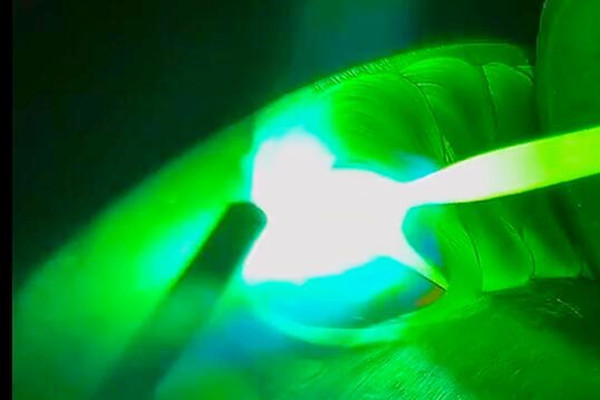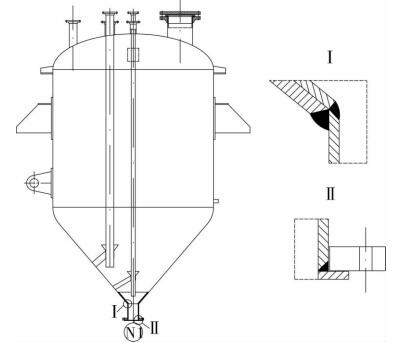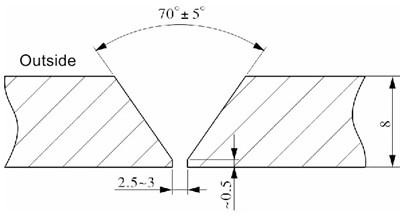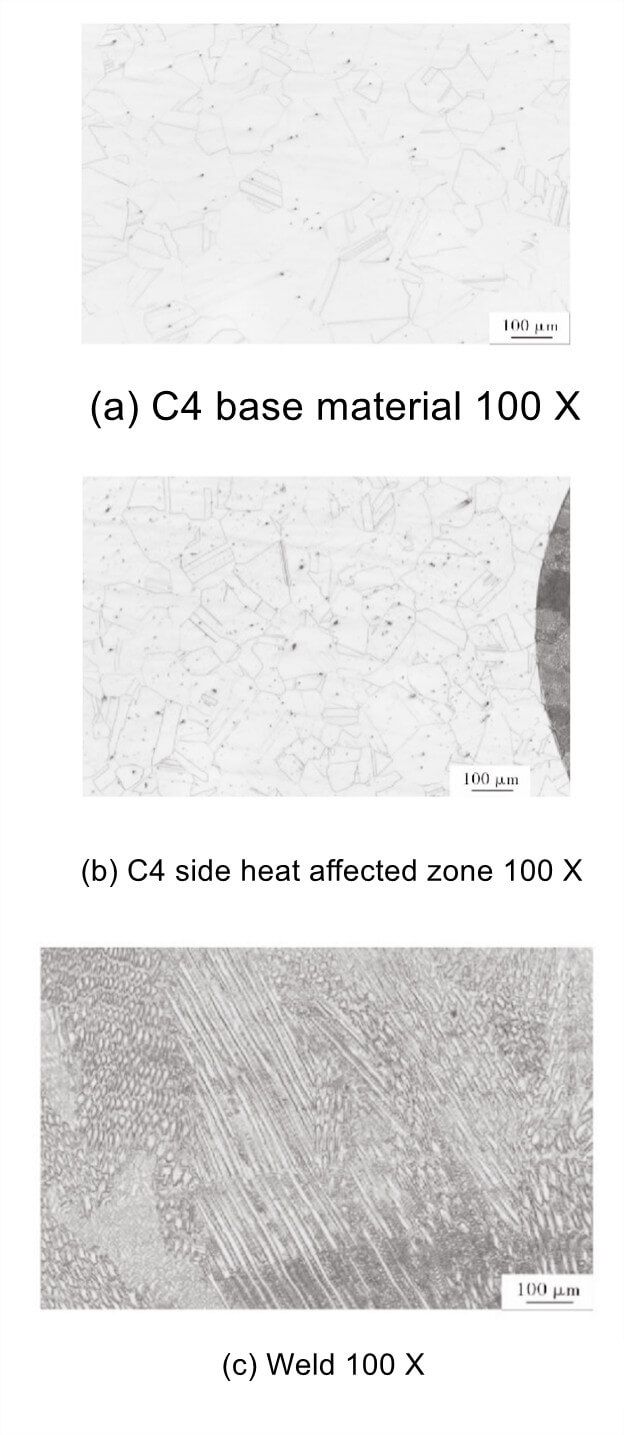To prevent medium corrosion, Hastelloy C4 material is chosen for the bottom of the waste tank, which belongs to Ni-Cr-Mo based corrosion-resistant nickel alloy with single-phase austenitic structure and has corrosion resistance welding characteristics. nickel alloy. The argon arc welding process is used. ERNiCrMo-7 welding wire is chosen. Through groove design, cleaning before welding, temperature control between passes, selection of low welding heat input and other process measures, welding process evaluation test and metallographic structural analysis of the welded joint, The results show that the established welding process has the mechanical properties and corrosion resistance of the welded connection.

0. Introduction
It is a waste liquid tank manufactured for a chemical company's HDI project. The medium is mainly HDI (cyclohexane diisocyanate) residual liquid. The shell is made of S31603 stainless steel and its structure is shown in Fig.
Taking into account the corrosivity of the medium in different locations, the opening of the N1 pipe at the bottom of the tank must be equipped with an overlapping flange, the nozzle and bushing ring must be made of Hastelloy C4, and the upper part of the nozzle must have a length of L=80 mm and a thickness of δ= 100 mm. The Hastelloy C4 cone is coated on the outer cone of the tailings tank to prevent corrosion. The shape of the solder joint in nozzle N1 is shown in Figures 1, II and includes welding between materials C4 and C4 and between materials C4 and Materials S31603 . The Hastelloy C4 material has few use cases in China and this manufacturing is also the first time it has been used. Therefore, it is necessary to study the welding performance of this material, conduct a qualification test, and formulate suitable welding procedures to ensure welding quality and usage requirements. 
Fig.1 Waste liquid container design
1. Chemical composition and mechanical properties
Hastelloy C4 corresponds to UNS No. N06455 in ASME and its chemical composition and mechanical properties are listed in Table 1.2. Hastelloy C4 is a corrosion-resistant nickel-based Ni-Cr-Mo alloy with a single-phase austenitic structure. Due to the high content of Cr and Mo, it is resistant to corrosion in reducing and oxidizing media, and also resists corrosion in mixed oxidation-reduction media. By reducing the content of C, Si and Fe and adding the stabilizing element Ti, resistance to intergranular corrosion is increased. It also has good resistance to pitting corrosion, crevice corrosion and stress corrosion cracking.
Table 1: Chemical composition of C4 material in %
| Chemical composition | W | Mn | Faith | P | s | Yes | No | co | You | Cr | Mo |
| standard value | ≤ 0.015 | ≤ 0.08 | ≤ 3.0 | ≤ 0.04 | ≤ 0.03 | ≤ 1.0 | grant | ≤ 2.0 | ≤ 0.7 | 14.0-18.0 | 14.0 – 17.0 |
| Retest value | 0.003 | <0.01 | 1 | <0.002 | 0.002 | <0.01 | 67.28 | 0.03 | <0.01 | 15.7 | 15.58 |
Table 2: Mechanical properties of material C4
| Project | R M /N.mm -2 | R t M /N.mm -2 | A/% |
| standard value | ≥690 | ≥276 | ≥40 |
| Retest value | 744 | 319 | 72 |
2. Weldability analysis
(1) Nickel-based corrosion-resistant alloys are very sensitive to hot cracking, which is easy to produce crystal cracks and liquefaction cracks during welding.
Cause of cracking: Nickel, sulfur and phosphorus readily form low melting point eutectics at high temperatures. When the welding heat input is large, the weld grain is large and there are more intergrain carbides and intermetallic compounds, which promote liquefaction cracking and increase the tendency of thermal cracking. Therefore, measures must be taken to control the welding heat input and limit the S, P and Si content of the weld during welding.
(2) Nickel-based weld metal is sensitive to porosity.
Causes of porosity: The mobility of liquid metal made of nickel-based alloys is poor and the gas cannot escape during welding; the temperature range between the solid and liquid phase of the nickel-based alloy is small, and the solubility of oxygen, carbon dioxide, hydrogen and other gases in liquid nickel is relatively large. However, when the weld is cooled, the solubility decreases significantly and the gas in the weld pool does not have time to escape and form pores. Therefore, contaminants such as oil and water in the welding area that can cause pores must be removed before welding. Deoxidizing elements such as manganese, titanium and niobium can be added to welding materials. During welding, protection against weld pool gases must be reinforced.
3. Preparation of welding process made of Hastelloy C4
3.1 Welding processes and welding materials
The argon arc welding process must be used according to the structural characteristics of the product. ERNiCrMo-7 welding wire with a diameter of φ mm; chemical composition see Table 3. When welding, argon protection is applied on the back, with argon purity of 99.99% and flow rate of 8-10 l/min.
Table 3: Chemical composition of ERNiCrMo-7 material in%
| Chemical composition | W | .Mn | Faith | P | s | Yes | Ass | No | co | You | Cr | Mo | B |
| standard value | ≤0.015 | ≤1.0 | ≤3.0 | ≤0.04 | ≤0.03 | ≤0.08 | ≤0.50 | Hello error | ≤2.0 | ≤0.7 | 14.0-18.0 | 2pm – 6pm | ≤0.50 |
| Retest value | 0.001 | 0.14 | 0.46 | 0.006 | 0.002 | 0.02 | 0.02 | grant | <0.11 | 0.19 | 15.8 | 15.73 | 0.1 |
Table.3.1 Mechanical properties of steel grade AWSERNiCrMo-7
|
Stretch limit R p0.2 (MPa) |
tensile strength Strength R M (MPa) |
Effects KV/Ku (J) |
renovation A (%) |
Reduction of cross section at rupture Z (%) |
Heat Treated Condition | Brinell hardness (HBW) |
|---|---|---|---|---|---|---|
| 215 (≥) | 979 (≥) | 42 | 11 | 13 | Solution and aging processes, annealing, off-aging, Q+T etc. | 434 |
Table.3.2 Physical properties of steel grade AWSERNiCrMo-7
|
temperature (°C) |
modulus of elasticity (GPa) |
Average coefficient of thermal expansion 10-6/(°C) between 20(°C) and |
O conductivity (W/m²°C) |
Specific heat capacity (J/kg·°C) |
Specific electrical resistance (Ωmm²/m) |
density (kg/dm³) |
Poisson's ratio, ν |
|---|---|---|---|---|---|---|---|
| 34 | – | – | 0.33 | – | |||
| 523 | 584 | – | 23.3 | 234 | – | ||
| 632 | – | 33 | 11.2 | 441 | 433 |
AWSERNiCrMo-7 Steel Heat Treatment
Heat treated: 1665°C – 1321°C
3.2 Groove design
Because nickel alloy liquid weld metal has low mobility and low penetration process characteristics, it is not easy to wet and expand. The joint must provide sufficient space for filling the metal and the groove must have a large root distance and groove angle and a small cutting edge height to avoid incomplete fusions and penetration failures during welding and to ensure that the metal of liquid solder fill the groove. The process qualification test adopts the butt joint groove shape as shown in Fig. 
Fig.2 Type of groove
3.3 Cleaning before welding
Cleaning before welding is very important when welding corrosion-resistant nickel alloys. Before welding, the welding area of the welding wire, Hastelloy C4 and S31603 stainless steel should be cleaned with acetone or absolute ethyl alcohol to remove oil, water and other dirt and prevent pores and cracks.
3.4 Preheating and interlayer temperature control
In general, corrosion-resistant nickel alloys do not require preheating before welding can be done at room temperature. When the welding temperature is below 2°C or below, the welding joint and the area greater than 300mm on both sides should be heated to 15-20°C to prevent the formation of air holes caused by condensation of humidity. Excessive welding heat input and interpass temperature during welding results in excessive grain size, increases the propensity for hot cracking, and reduces corrosion resistance. The interlayer temperature must be kept below 100 °C.
3.5 Welding process parameters
Due to the welding properties of nickel-based alloys, a low welding heat input must be used to avoid thermal cracking. Multi-pass and multi-pass welding must be used. Horizontal oscillation is prohibited during welding, linear movements must be carried out as much as possible. The formulated parameters of the welding process can be found in Table 4.
Table 4: Welding process parameters
| Welding process | Number of layers | welding material | Specification/mm | polarity | Welding current/A | Arc voltage/V | Welding speed/cm. min -1 | Linear energy/kJ.cm -1 |
| TIG | 1 | ERNiCrMo-7 | .2.4 | DCEN | 90 – 110 | 11- 13 | 10 – 15 | ≤ 8.58 |
| TIG | 2 – 5 | ERNiCrMo-7 | .2.4 | DCEN | 110 – 140 | 11- 13 | 10 – 15 | ≤ 10.92 |
4. Welding Procedure Test
In accordance with NB/T47014-2011 and the technical requirements, according to the welding method proposed above, two groups of welding method evaluation tests are carried out on 8mm thick plates S31603 and C4 (N06455). One group is welding between S31603 and C4 and the sample number is 863#; One group is phase welding between C4 and C4 and the sample number is 864#.
Test items such as tensile strength test, flexural test, intergranular corrosion test and chemical composition analysis of welded joints should be carried out after 100% RT and 100% PT test on the flawless test piece. The intergranular corrosion test result is 863#: Intergranular corrosion test (2 pieces), accepted according to GB/T15260-1994 Standard B method; Intergranular corrosion test (2 pieces) accepted in accordance with GB/T15260-1994 B standard. See Table 5-7 for test results of other items.
Table 5: Tensile test results
| Sample number | Tensile strength/N.mm -2 | Breaking point and characteristics |
| 863 # -1 | 620 | Plastic fracture in the heat-affected zone |
| 863 # -two | 620 | Plastic fracture in the heat-affected zone |
| 864 # - 1 | 735 | Plastic fracture in the heat-affected zone |
| 864 # - two | 735 | Plastic fracture in the heat-affected zone |
Table 6: Flexion test results
| Sample number | Example type | Bending angle/° | Test result |
| 863 # | Surface bending | 180 | Qualified (2 pieces) |
| 863 # | Dorsal curvature | 180 | Qualified (2 pieces) |
| 864 # | Surface bending | 1 80 | Qualified (2 pieces) |
| 864 # | Dorsal curvature | 180 | Qualified (2 pieces) |
Table 7: Chemical composition of the solder (%)
| Chemical element | W | Yes | Mn | s | P | No | Cr | Mo | Faith | co | You |
| 863# Sample (outer surface at weld centerline) | 0.003 | 0.02 | 0.16 | 0.005 | 0.02 3 | 67. 28 | 15.69 | 2:95 p.m. | 1. 28 | 0.05 | 0.07 |
| 864# example | 0.002 | 0.03 | 0.06 | 0.007 | 0.025 | 67.68 | 16 | 14.63 | 1.17 | 0.07 | 0.04 |
From the test results, it can be seen that the tensile strength value of sample No. 863 # is greater than the minimum value of 490 N/mm 2 the tensile strength specified in the stainless steel standard S31603; The tensile strength value of sample No. 864 # is greater than the minimum value of 690 N/mm 2 the tensile strength specified in the standard for solid Hastelloy C4. All are plastic fractures in the heat-affected zone of the welded joint. When two groups of surface bending and back bending test samples are bent by 180°, there is no open defect in the welded joint on the tensile surface and heat-affected zone, which meets the requirements of NB/T47014. The sample for the intergranular corrosion test is subjected to a bending test after continuous heating for 24 hours in a solution of copper sulfate and 16% sulfuric acid. The stressed surface must be free of cracks and other defects and meet the requirements of the standard, indicating good resistance to corrosion of the welded joint. It can be seen that after passing the non-destructive test, a sample of the specimen is taken for mechanical properties testing. The results of the tensile strength and flexural properties of the welded joint meet the requirements of NB/T47014-2011. The chemical composition and intergranular corrosion test of the welded joint are qualified, proving that the welding process is good and can guarantee the mechanical properties and intergranular corrosion resistance of the welded joint.
5. Metallographic inspection of the welded joint
To better understand the effects of the welding process on the welded joint, macroscopic and microscopic metallographic tests were carried out on the samples. For evaluation, a sample is taken from two groups, the sample numbers are 863# and 864# respectively;
The macroscopic metallographic examination is carried out with a 10x magnifying glass, and the cross section of the welded joint of the two samples is free from defects such as air holes, slag inclusions, cracks, incomplete fusion and incomplete penetration.
The microscopic metallographic examination is shown in Figure 3.4. Test results of sample No. 863: The base metal and heat-affected zone of S31603 have an austenite structure plus a small amount of δ ferrite, the weld has an austenite structure plus a trace of δ ferrite, the heat-affected zone heat on the C4 side and the base metal has an austenitic structure. Test results for sample #864: The base metal and the heat-affected zone on the C4 side have an austenitic structure, and the weld has an austenite structure plus a trace of δ-ferrite. From the microstructure diagram, it can be seen that the weld of the two samples is fine and dense, without large groups of grains and harmful phase precipitation, indicating good performance of the welding process. 
Fig. 3 Microstructure of sample 863 # 
Fig. 4 Microstructure of sample 864 #
6. Conclusion
- (1) Hastelloy C4 is a corrosion-resistant nickel-based Ni-Cr-Mo alloy with a single-phase austenitic structure. When welding, it is sensitive to hot cracks and air holes. By using this welding process, qualified welded connections can be achieved.
- (2) The argon arc welding process must be used. ERNiCrMo-7 welding wire must be used. Pure argon protection must be worn on the back. The welding wire and groove surface must be thoroughly cleaned before welding. The groove angle must be increased accordingly. A low heat supply must be used. The interlayer temperature must be kept below 100 °C. Multilayer and multilayer welding must be carried out. Through the process evaluation test, the tensile strength of C4 and C4 welded joints is 735N/mm. 2 and the tensile strength of welded joints C4 and S31603 is 620N/mm 2 . Surface bending and bending are qualified; intergranular corrosion is accepted according to the GB/T15260-1994 B standard, which indicates that the mechanical properties and corrosion resistance of the welded joint meet the standard requirements.
- (3) The welds at the welded joints have an austenitic structure with traces of δ ferrite, the heat-affected zone and the base metal on the C4 side have an austenitic structure, the heat-affected zone and the base metal on the S31603 side have an austenitic structure with a small amount of δ ferrite, the structure of the solder joint is good, there is no coarse grain, there is no harmful phase precipitation, and the welding process works well.

























































